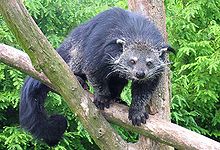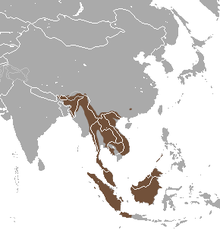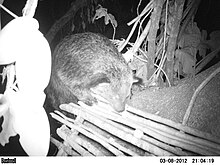Binturong
| Binturong | |
|---|---|

| |
| Scientific classification | |
| Kingdom: | |
| Phylum: | |
| Class: | |
| Order: | |
| Family: | |
| Subfamily: | |
| Genus: | Arctictis Temminck, 1824
|
| Species: | A. binturong
|
| Binomial name | |
| Arctictis binturong[2] (Raffles, 1822)
| |

| |
| Binturong range | |
The binturong (/bɪnˈtuːrɒŋ/ bin-TOO-rong) (Arctictis binturong), also known as bearcat, is a viverrid native to South and Southeast Asia. It is uncommon in much of its range, and has been assessed as Vulnerable on the IUCN Red List because of a declining population trend that is estimated at more than 30% over the last three decades.[1]
Although called 'bearcat', this omnivorous mammal is related to neither bears nor cats but to the palm civets of Asia. It is a monotypic genus.[3] Its genus name Arctictis means 'bear-weasel', from Greek arkt- 'bear' + iktis 'weasel'.[4]
In 1822, Thomas Stamford Raffles first described a specimen from Malacca.[5] In Riau, Indonesia it was known as tenturun.[6]
Characteristics

The body of the binturong is long and heavy, with short, stout legs. It has a thick fur of strong black hair. The bushy and prehensile tail is thick at the root, gradually diminishing in size to the extremity, where it curls inwards. The muzzle is short and pointed, somewhat turned up at the nose, and is covered with bristly hairs, brown at the points, which lengthen as they diverge, and form a peculiar radiated circle round the face. The eyes are large, black and prominent. The ears are short, rounded, edged with white, and terminated by tufts of black hair. There are six short rounded incisors in each jaw, two canines, which are long and sharp, and six molars on each side. The hair on the legs is short and of a yellowish tinge. The feet are five-toed, with large strong claws; the soles are bare, and applied to the ground throughout the whole of their length; the hind ones are longer than the fore.[5]
In general build the binturong is essentially like Paradoxurus and Paguma but more massive in the length of the tail, legs and feet, in the structure of the scent glands and larger size of rhinarium, which is more convex with a median groove being much narrower above the philtrum. The contour hairs of the coat are much longer and coarser, and the long hairs clothing the whole of the back of the ears project beyond the tip as a definite tuft. The anterior bursa flap of the ears is more widely and less deeply emarginate. The tail is more muscular, especially at the base, and in colour generally like the body, but commonly paler at the base beneath. The body hairs are frequently partly whitish or buff, giving a speckled appearance to the pelage, sometimes so pale that the whole body is mostly straw-coloured or grey, the young being often at all events paler than the adults, but the head is always closely speckled with grey or buff. The long mystacial vibrissae are conspicuously white, and there is a white rim on the summit of the otherwise black ear. The glandular area is whitish.[3]
The tail is nearly as long as the head and body, which ranges from 28 to 33 in (71 to 84 cm); the tail is 26 to 27 in (66 to 69 cm) long.[7] Some captive binturongs measured from 2 ft 6 in (76 cm) to 3 ft (91 cm) in head and body with a tail of 2 ft 4 in (71 cm).[8] Mean weight of captive adult females is 21.9 kg (48 lb) with a range from 11 to 32 kg (24 to 71 lb). Captive animals often weigh more than wild counterparts.[9]
Both sexes have scent glands; in females on either side of the vulva, in males between the scrotum and penis.[10][11] Their musk glands emit an odor reminiscent of popcorn or corn chips, likely due to the volatile compound 2-acetyl-1-pyrroline, found in their urine, which is also produced in the Maillard reaction at high temperatures.[12]
The binturong is the largest living species of the Viverridae, only rivaled by the African civet.[13] Females are 20% larger than males.[14]
Distribution and habitat
Binturongs occur from India, Nepal, Bangladesh, Bhutan, Myanmar, Thailand, Malaysia to Laos, Cambodia, Vietnam and Yunnan in China, and from Sumatra, Kalimantan and Java in Indonesia to Palawan in the Philippines.[1]
Binturongs are confined to tall forest.[15] They are not uncommon in the forested plains and hills throughout Assam, but more common in foothills and hills with good tree cover. They have been recorded in Manas National Park, in Dulung and Kakoi Reserved Forests of the Lakhimpur district, in the hill forests of Karbi Anglong, North Cachar Hills, Cachar and Hailakandi Districts.[16] In Myanmar, binturongs were photographed on the ground in the Tanintharyi Nature Reserve at an altitude of 60 m (200 ft), in the Hukaung Valley at altitudes from 220–280 m (720–920 ft), in the Rakhine Yoma Elephant Reserve at 580 m (1,900 ft) and at three other sites up to 1,190 m (3,900 ft) elevation.[17] In Thailand's Khao Yai National Park, several individuals were observed feeding in a fig tree and on a vine.[18] In Laos, they have been observed in extensive evergreen forest.[19] In Malaysia, binturongs were recorded in secondary forest surrounding a palm estate that was logged in the 1970s.[20] In Palawan, they are found in primary and secondary lowland forest, including grassland–forest mosaic from sea level to 400 m (1,300 ft).[21]
Distribution of subspecies
Nine subspecies have been recognized forming two clades. The northern clade from mainland Asia has been separated from the Sundaic clade by the Isthmus of Kra.[22]
- A. b. binturong (Raffles, 1821) – ranges from Malacca to southwestern Thailand and Tenasserim;[23]
- A. b. albifrons (Cuvier, 1822) – is distributed in the Eastern Himalayas to Bhutan, northern Myanmar and Indochina;[23]
- A. b. penicillatus (Temminck, 1835) – lives in Java;[22]
- A. b. whitei (Allen, 1910) – lives in Palawan, Philippines;[22]
- A. b. pageli (Schwarz, 1911) – lives in Borneo;[22]
- A. b. gairdneri (Thomas, 1916) – lives in northern Thailand;[22]
- A. b. niasensis (Lyon, 1916) – lives in Sumatra;[22]
- A. b. kerkhoveni (Sody, 1936) – lives in Bangka Island;[22]
- A. b. memglaensis (Wang and Li, 1987) – is distributed in Yunnan province;[22]
Ecology and behavior

The Binturong is active during the day and at night.[18][19] Three sightings in Pakke Tiger Reserve were by day.[24] Thirteen camera trap photograph events in Myanmar involved one around dusk, seven in full night and five in broad daylight. All photographs were of single animals, and all were taken on the ground. As binturongs are not very nimble, they may have to descend to the ground relatively frequently when moving between trees.[17]
Five radio-collared binturongs in the Phu Khieo Wildlife Sanctuary exhibited an arrhythmic activity dominated by crepuscular and nocturnal tendencies with peaks in the early morning and late evening. Reduced inactivity periods occurred from midday to late afternoon. They moved between 25 m (82 ft) and 2,698 m (8,852 ft) daily in the dry season and increased their daily movement to 4,143 m (13,593 ft) in the wet season. Ranges sizes of males varied between 0.9 km2 (0.35 sq mi) and 6.1 km2 (2.4 sq mi). Two males showed slightly larger ranges in the wet season. Their ranges overlapped between 30–70%.[25] The average home range of a radio-collared female in the Khao Yai National Park was estimated at 4 km2 (1.5 sq mi), and the one of a male at 4.5 to 20.5 km2 (1.7 to 7.9 sq mi).[26]
The binturong is essentially arboreal. Pocock observed the behaviour of several captive individuals in the London Zoological Gardens. When resting they lie curled up, with the head tucked under the tail. They seldom leaped, but climbed skillfully, albeit slowly, progressing with equal ease and confidence along the upper side of branches or, upside down, beneath them. The prehensile tail was always ready as a help. They descended the vertical bars of the cage head first, gripping them between their paws and using the prehensile tail as a check. When irritated they growled fiercely. When on the prowl they periodically uttered a series of low grunts or a hissing sound made by expelling air through partially opened lips.[3]
The binturong uses the tail to communicate.[10] It moves about gently, often coming to a stop, and often using the tail to keep balance, clinging to a branch. It shows a pronounced comfort behaviour associated with grooming the fur, shaking and licking the hair, and scratching. Shaking is the most characteristic element of comfort behaviour.[27]
The species is normally quite shy, but aggressive when harassed. It is reported to initially urinate or defecate on a threat and then, if teeth-baring and snarling does not deter the threat, it uses its powerful jaws and teeth in self-defense. When threatened, the binturong will usually flee into a nearby tree, but as a defense mechanism the binturong may sometimes balance on its tail and flash its claws to appear threatening to potential predators. Predation on adult binturong is reportedly quite rare by sympatric species like leopard, clouded leopard and reticulated python.[28]
Diet
Binturongs are omnivorous, feeding on small mammals, birds, fish, earthworms, insects and fruits.[7] Captive binturongs are particularly fond of plantains, but would also eat fowls' heads and eggs.[5] They also prey on rodents.[15] Fish and earthworms are likely unimportant items in their diet, as they are neither aquatic nor fossorial, coming across such prey only when opportunities present themselves. Since they do not have the attributes of a predatory mammal, most of the binturong's diet is probably of vegetable matter.[3] Figs are a major component of their diet.[18][24][29]
The binturong is an important agent for seed dispersal, especially for those of the strangler fig, because of its ability to scarify the seed's tough outer covering.[30]
In captivity, the binturong's diet includes commercially prepared meat mix, bananas, apples, oranges, canned peaches and mineral supplement.[9]
Reproduction
The average age of sexual maturation is 30.4 months for females and 27.7 months for males. The estrous cycle of the binturong lasts 18 to 187 days, with an average of 82.5 days. Gestation lasts 84 to 99 days. Litter size in captivity varies from one to six young, with an average of two young per birth. Neonates weigh between 283.8 and 340.5 g (0.626 and 0.751 lb). Fertility lasts until 15 years of age.[9]
The maximum known lifespan in captivity is thought to be over 25 years of age.[31]
Threats

Major threats to the binturong are habitat loss and degradation of forests through logging and conversion of forests to non-forest land-uses throughout the binturong's range. Habitat loss has been severe in the lowlands of the Sundaic part of its range, and there is no evidence that the binturong uses the plantations that are largely replacing natural forest. In China, rampant deforestation and opportunistic logging practices have fragmented suitable habitat or eliminated sites altogether. In the Philippines, it is captured for the wildlife trade, and in the south of its range it is also taken for human consumption. In Laos, it is one of the most frequently displayed caged live carnivores and skins are traded frequently in at least Vientiane. In parts of Laos, it is considered a delicacy and also traded as a food item to Vietnam.[1]
The Orang Asli of Malaysia keep binturong as pets.
Conservation
India included the binturong in CITES Appendix III. It is protected in Malaysia, and is listed as critically endangered on the China Red List.[1]
In captivity

Binturongs are common in zoos, and captive individuals represent a source of genetic diversity essential for long-term conservation. Typically, zoo animals have unknown geographic origin or are the offspring of several generations of captive-bred animals with no information on the geographic origin of the founders.[22]
In captivity, the binturong has been noted for its intelligence as well as its curious disposition. However, its occasional ill-temperament makes it a difficult pet at best and it is better handled by experienced wildlife handlers and zookeepers.[28][failed verification]
The Cincinnati Zoo brings a captive binturong named Lucy to various sporting events for the University of Cincinnati Bearcats. She is quite tame, and alternates between perching on her handler's shoulder and walking around on a leash, similar to a housepet.[32]
See also
References
- ^ a b c d e Willcox, D.H.A.; Chutipong, W.; Gray, T.N.E.; Cheyne, S.; Semiadi, G.; Rahman, H.; Coudrat, C.N.Z.; Jennings, A.; Ghimirey, Y.; Ross, J.; et al. (2016). "Arctictis binturong". The IUCN Red List of Threatened Species. 2016. IUCN: e.T41690A45217088. doi:10.2305/IUCN.UK.2016-1.RLTS.T41690A45217088.en. Retrieved 16 January 2018.
- ^ Wozencraft, W. C. (2005). "Order Carnivora". In Wilson, D. E.; Reeder, D. M. (eds.). Mammal Species of the World: A Taxonomic and Geographic Reference (3rd ed.). Johns Hopkins University Press. p. 549. ISBN 978-0-8018-8221-0. OCLC 62265494.
- ^ a b c d Pocock, R. I. (1939). The fauna of British India, including Ceylon and Burma. Mammalia. – Volume 1. Taylor and Francis, London. Pp. 431–439.
- ^ Scherren, H. (1902). The Encyclopædic Dictionary. Cassell and Company, London.
- ^ a b c Raffles, T. S. (1822). XVII. Descriptive Catalogue of a Zoological Collection, made on account of the Honourable East India Company, in the Island of Sumatra and its Vicinity, under the Direction of Sir Thomas Stamford Raffles, Lieutenant-Governor of Fort Marlborough', with additional Notices illustrative of the Natural History of those Countries. The Transactions of the Linnean Society of London, Volume XIII: 239–274.
- ^ Wilkinson, R. J. (1901). A Malay-English dictionary Kelly & Walsh Limited, Hongkong, Shanghai and Yokohama.
- ^ a b Blanford, W. T. (1888–91). 57. Arctictis binturong. Pages 117–119 in: The fauna of British India, including Ceylon and Burma. Mammalia. Taylor and Francis, London.
- ^ Arivazhagan, C. and K. Thiyagesan (2001). Studies on the Binturongs (Arctictis binturong) in captivity at the Arignar Anna Zoological Park, Vandalur. Zoos' Print Journal 16 (1): 395–402.
- ^ a b c Wemmer, C.; J. Murtaugh (1981). "Copulatory Behavior and Reproduction in the Binturong, Arctictis binturong" (PDF). Journal of Mammalogy. 62 (2): 342–352. doi:10.2307/1380710. JSTOR 1380710.
- ^ a b Story, H. E. (1945). "The External Genitalia and Perfume Gland in Arctictis binturong". Journal of Mammalogy. 26 (1): 64–66. doi:10.2307/1375032.
- ^ Kleiman, D. G. (1974). "Scent marking in the binturong, Arctictis binturong" (PDF). Journal of Mammalogy. 55 (1): 224–227.
- ^ Greene, Lydia K.; Wallen, Timothy W.; Moresco, Anneke; Goodwin, Thomas E.; Drea, Christine M. (2016-04-07). "Reproductive endocrine patterns and volatile urinary compounds of Arctictis binturong: discovering why bearcats smell like popcorn". The Science of Nature. 103 (5–6). doi:10.1007/s00114-016-1361-4. ISSN 0028-1042.
- ^ Hunter, L. (2011). Carnivores of the World. Princeton University Press, ISBN 9780691152288
- ^ San Diego Zoo. "Mammal: Binturong". Sandiegozoo.org. Retrieved 6 August 2012.
- ^ a b Lekalul, B. and McNeely, J. A. (1977). Mammals of Thailand. Association for the Conservation of Wildlife, Bangkok.
- ^ Choudhury, A. (1997). The distribution and status of small carnivores (mustelids, viverrids, and herpestids) in Assam, India. Small Carnivore Conservation 16: 25–26.
- ^ a b Than Zaw, Saw Htun, Saw Htoo Tta Po, Myint Maung, Lynam, A. J., Kyaw Thinn Latt and Duckworth, J. W. (2008). Status and distribution of small carnivores in Myanmar Archived April 28, 2015, at the Wayback Machine. Small Carnivore Conservation 38: 2–28.
- ^ a b c Nettlebeck, A. R. (1997). Sightings of Binturongs Arctictis binturong in the Khao Yai National Park, Thailand. Small Carnivore Conservation 16: 21–24.
- ^ a b Duckworth, J. W. (1997). Small carnivores in Laos: a status review with notes on ecology, behaviour and conservation. Small Carnivore Conservation 16: 1–21.
- ^ Azlan, J. M. (2003). The diversity and conservation of mustelids, viverrids, and herpestids in a disturbed forest in Peninsular Malaysia. Small Carnivore Conservation 29 Archived 2015-01-29 at the Wayback Machine: 8–9.
- ^ Rabor, D. S. (1986). Guide to the Philippine flora and fauna. Natural Resources Management Centre. Ministry of Natural Resources and University of the Philippines.
- ^ a b c d e f g h i Cosson, L., Grassman, L. L., Zubaid, A., Vellayan, S., Tillier, A., and Veron, G. (2007). Genetic diversity of captive binturongs (Arctictis binturong, Viverridae, Carnivora): implications for conservation. Journal of Zoology 271 (4): 386–395.
- ^ a b Ellerman, J. R., Morrison-Scott, T. C. S. (1966). Checklist of Palaearctic and Indian mammals 1758 to 1946. Second edition. British Museum of Natural History, London. Page 290
- ^ a b Datta, A. (1999). Small carnivores in two protected areas of Arunachal Pradesh. Journal of the Bombay Natural History Society 96: 399–404.
- ^ Grassman, L. I. Jr.; M. E. Tewes; N. J. Silvy (2005). "Ranging, habitat use and activity patterns of binturong Arctictis binturong and yellow-throated marten Martes flavigula in north-central Thailand" (PDF). Wildlife Biology. 11 (1): 49–57. doi:10.2981/0909-6396(2005)11[49:RHUAAP]2.0.CO;2.
- ^ Austin, S. C. (2002). Ecology of sympatric carnivores in the Khao Yai National Park, Thailand. PhD thesis, Texas University.
- ^ Rozhnov, V. V. (1994). Notes on the behaviour and ecology of the Binturong (Arctictis binturong) in Vietnam. Small Carnivore Conservation 10 Archived 2015-04-29 at the Wayback Machine: 4–5.
- ^ a b Ismail, M. A. Hj. (??). Binturong Archived February 3, 2013, at the Wayback Machine. Universiti Kebangsaan Malaysia
- ^ Lambert, F. (1990). Some notes on fig-eating by arboreal mammals in Malaysia. Primates 31 (3): 453–458.
- ^ Colon, C. P.; Campos-Arceiz, A. (2013). "The impact of gut passage by Binturongs (Arctictis binturong) on seed germination" (PDF). The Raffles Bulletin of Zoology. 61 (1): 417–421.
{{cite journal}}: Unknown parameter|lastauthoramp=ignored (|name-list-style=suggested) (help) - ^ Macdonald, D.W. (2009). The Encyclopedia of Mammals. Oxford University Press, Oxford.
- ^ "GoBEARCATS.COM - University Of Cincinnati Official Athletic Site".
External links
- Palawan Council
- Wildlife Waystation
- Bearcat Cubs at Cincinnati Zoo
- . Encyclopædia Britannica (11th ed.). 1911.

